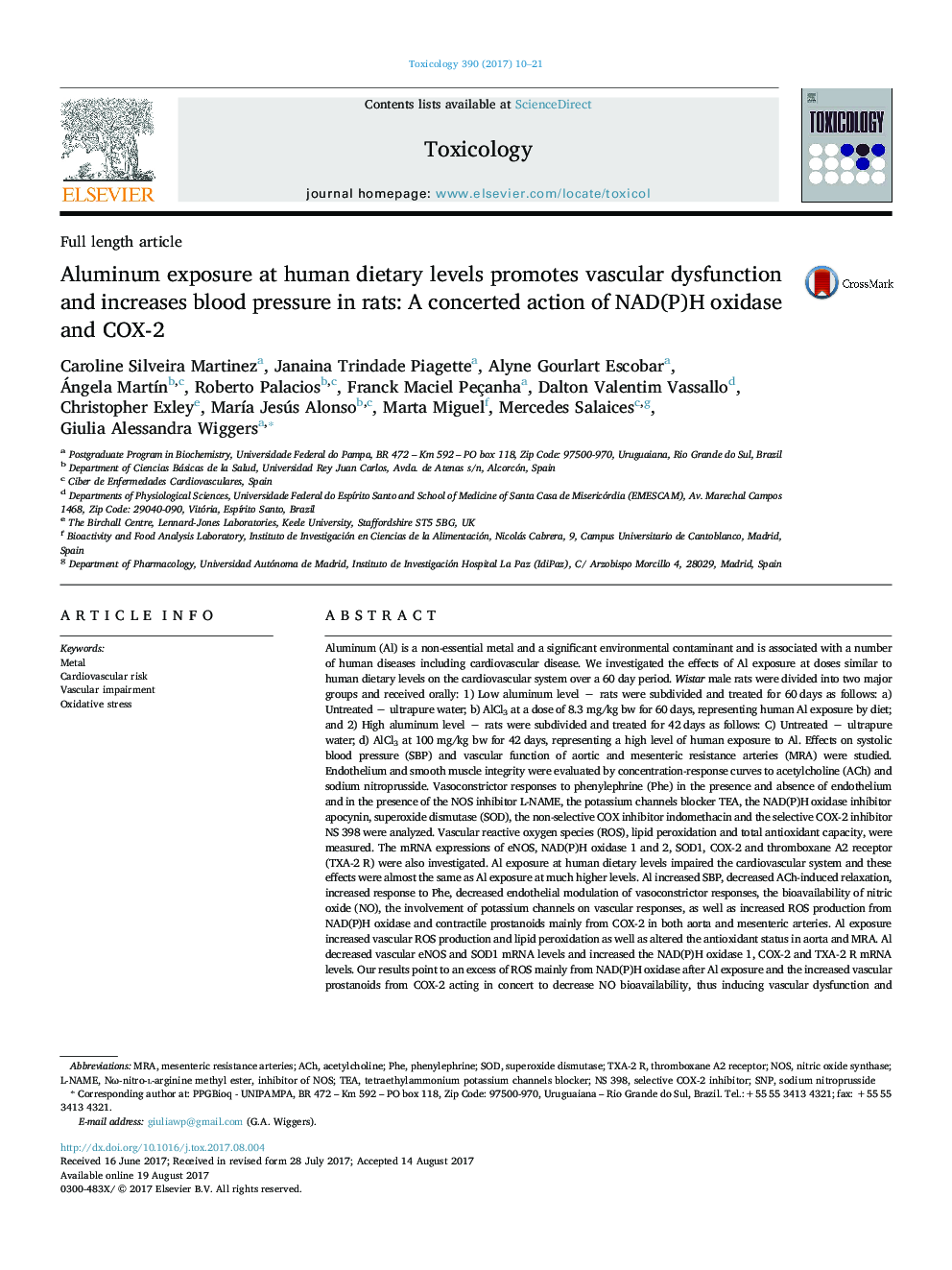| کد مقاله | کد نشریه | سال انتشار | مقاله انگلیسی | نسخه تمام متن |
|---|---|---|---|---|
| 5561684 | 1562282 | 2017 | 12 صفحه PDF | دانلود رایگان |

- Al at human dietary levels reaches a threshold to induce cardiovascular dysfunction.
- Al exposure at low doses promotes vascular dysfunction and increases blood pressure.
- Al induces endothelial dysfunction and impairs endothelial NO bioavailability.
- This study raises the concern regarding safe values for human exposure to Al.
Aluminum (Al) is a non-essential metal and a significant environmental contaminant and is associated with a number of human diseases including cardiovascular disease. We investigated the effects of Al exposure at doses similar to human dietary levels on the cardiovascular system over a 60Â day period. Wistar male rats were divided into two major groups and received orally: 1) Low aluminum level â rats were subdivided and treated for 60Â days as follows: a) Untreated â ultrapure water; b) AlCl3 at a dose of 8.3Â mg/kg bw for 60Â days, representing human Al exposure by diet; and 2) High aluminum level â rats were subdivided and treated for 42Â days as follows: C) Untreated â ultrapure water; d) AlCl3 at 100Â mg/kg bw for 42Â days, representing a high level of human exposure to Al. Effects on systolic blood pressure (SBP) and vascular function of aortic and mesenteric resistance arteries (MRA) were studied. Endothelium and smooth muscle integrity were evaluated by concentration-response curves to acetylcholine (ACh) and sodium nitroprusside. Vasoconstrictor responses to phenylephrine (Phe) in the presence and absence of endothelium and in the presence of the NOS inhibitor L-NAME, the potassium channels blocker TEA, the NAD(P)H oxidase inhibitor apocynin, superoxide dismutase (SOD), the non-selective COX inhibitor indomethacin and the selective COX-2 inhibitor NS 398 were analyzed. Vascular reactive oxygen species (ROS), lipid peroxidation and total antioxidant capacity, were measured. The mRNA expressions of eNOS, NAD(P)H oxidase 1 and 2, SOD1, COX-2 and thromboxane A2 receptor (TXA-2 R) were also investigated. Al exposure at human dietary levels impaired the cardiovascular system and these effects were almost the same as Al exposure at much higher levels. Al increased SBP, decreased ACh-induced relaxation, increased response to Phe, decreased endothelial modulation of vasoconstrictor responses, the bioavailability of nitric oxide (NO), the involvement of potassium channels on vascular responses, as well as increased ROS production from NAD(P)H oxidase and contractile prostanoids mainly from COX-2 in both aorta and mesenteric arteries. Al exposure increased vascular ROS production and lipid peroxidation as well as altered the antioxidant status in aorta and MRA. Al decreased vascular eNOS and SOD1 mRNA levels and increased the NAD(P)H oxidase 1, COX-2 and TXA-2 R mRNA levels. Our results point to an excess of ROS mainly from NAD(P)H oxidase after Al exposure and the increased vascular prostanoids from COX-2 acting in concert to decrease NO bioavailability, thus inducing vascular dysfunction and increasing blood pressure. Therefore, 60-day chronic exposure to Al, which reflects common human dietary Al intake, appears to pose a risk for the cardiovascular system.
Journal: Toxicology - Volume 390, 1 September 2017, Pages 10-21